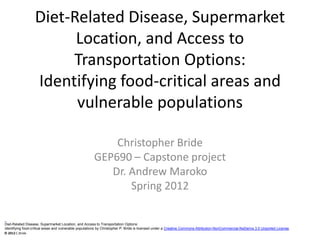
Supermarket Location, Tranportation Options, and their relationship to Diet-Related Disease
- 1. Diet-Related Disease, Supermarket Location, and Access to Transportation Options: Identifying food-critical areas and vulnerable populations Christopher Bride GEP690 – Capstone project Dr. Andrew Maroko Spring 2012 Diet-Related Disease, Supermarket Location, and Access to Transportation Options: Identifying food-critical areas and vulnerable populations by Christopher P. Bride is licensed under a Creative Commons Attribution-NonCommercial-NoDerivs 3.0 Unported License. © 2012 C.Bride
- 2. Abstract • This study is focused on identifying at risk populations for diet related disease through the analysis of census tract data, supermarket locations, and area hospital diagnostic (ICD-9) codes. • The project is about population, not food deserts. An individual can live in a food desert and still have access to healthy food choices (specifically, supermarkets) throughout the day by their travel habits and various modes of transportation. • Transportation options will be analyzed to evaluate their influence on the health and decisions made regarding food.
- 3. Objectives: • Identify a relationship between diet- related disease and location of supermarkets with respect to the population • Determine at-risk census tracts • Incorporate transit options into findings
- 4. Methodology • Create 3 classes of maps: – Disease Diagnosis – Transit Options – Supermarket Proximity to various transit options • Create three indices – Transportation (subway and car) – Supermarket proximity – Diet-Related Disease Diagnosis (total DRD rates) Combine indices into one Master Index to reveal relationships between location, mobility and health
- 5. 2. Calculate 1. Create .8km 1. Obtain diagnosis Flow Chart population w/in 2. Join with Census Polygons with data from and outside Network Dataset tract table polygons infoshare.org 3. Convert to 4.Map according to 3. Calculate 4. Sum percentages per accessibility (not percentage of percentages of population w/ICD9 census tract lack of access) Mobility code relevant diagnosis Subway Index 5. Map according to Diagnosis Access Index Diet-Related 2.Convert to Disease 1. Obtain car data from census number of cars (from households Index with cars) Car 3. Calculate percentage of 4. Map according to car access per Access population w/car (one car per person) census tract Index 2.Calculate 1.Create .8km population w/in Polygons with and outside Network Dataset polygons Supermarket Master Index and Access Index final evaluation 3. Convert to 4.Map according to percentages per accessibility (not census tract lack of access)
- 6. Diet-Related Disease Rates Index µ Data Source: www.infoshare.org
- 8. Transit Index Source: NYC MTA developers resource
- 9. Bronx Subway Access Convert polygons to census tract data 61% of Bronx pop. lives within .8km of a subway stop, 19.6% have access to a car* *Data source: US Census Bureau
- 10. GeoProcessing the Transit Map Clipped and erased layers Original polygon source Dissolve census tracts to rejoin fragments Union clipped and erase layers
- 11. Data source: US Census Bureau
- 12. Primary Input: Access To Transportation
- 13. Bus Access – Why is it not included? [#Bus stops per census tract/(population/area)] Homogenous distribution of bus stops per population density would of have a net effect of 0 on the mobility index.
- 14. Source data: spatiality.com, US Census Bureau
- 15. Supermarket Access 74.7% of Bronx residents live within .8km of a supermarket, 55% of subway stops have a supermarket w/in 1 block
- 16. GeoProcessing the Supermarket Index Original polygon source “Clipped” and “Erased” layers Clip and erase “Union” “Dissolve” census tracts to rejoin fragments
- 17. Primary Input: Supermarket Index Data source: US Census Bureau
- 18. Primary Input: Access To Transportation Data source: US Census Bureau
- 19. Primary Input: DRD Index Data source: US Census Bureau, www.infoshare.org
- 20. Combination of Indexes • • + - =
- 23. Afterthought: Comparing Diagnosis and Food/Mobility to get a perspective on the accuracy of my method
- 24. References and Datasets Census tract, water, population, car ownership data and shapefiles obtained from: • US Census Bureau. (2008). 2008 tiger/line® shapefiles for: New York. Retrieved from http://www2.census.gov/cgi-bin/shapefiles/state-files?state=36 Diet-Related Disease Diagnosis data obtained from: • Hospital sparks/icd-9 code data for the Bronx, NY. (2012, February 1). Retrieved from http://www.infoshare.org Subway station point, subway line, bus station, and bus line data sets obtained from: • New York City MTA. (2012, February 1). MTA Developers Resources. Retrieved from http://www.mta.info/developers/download.html • Romalewski, S. (2010, July 8). MTA GIS data update. Retrieved from http://spatialityblog.com/2010/07/08/mta-gis-data-update/ Supermarket location data obtained from: GoogleEarth query (2012)